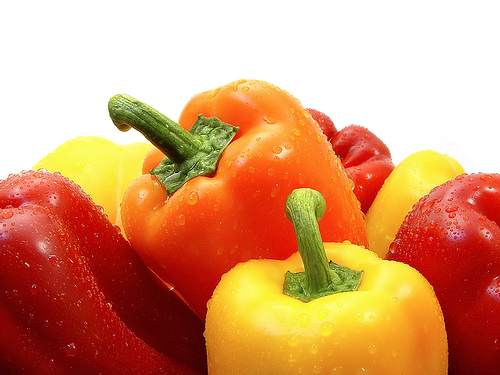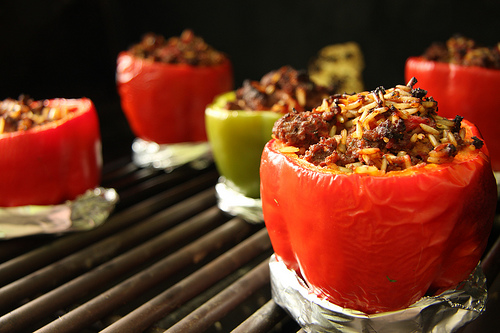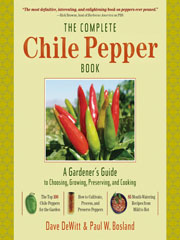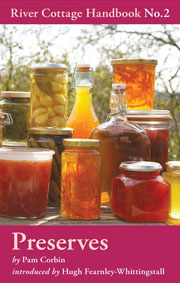We quite often get asked by readers for advice about about growing bell peppers from seed. While most of the advice on this site is dedicated to growing hot peppers, we also grow our fair share of sweet peppers. Bell peppers are not only easy to grow but are great to cook with – both in hot dishes or cold salads.
Bell peppers are from the same family as chilli peppers, the only difference being that bell peppers do not contain any capsaicin which is the chemical that produces the heat in hot peppers.
Below we’ll try to set out all of the information you’ll need to know in order to grow your own bell peppers.
 image by dandy_fsj
image by dandy_fsj
When To Plant Bell Peppers
As with growing chilli peppers and many other types of vegetable the key to a good harvest is to maximize your growing season. You should aim to plant your pepper seeds about 6 weeks before the last frost arrives. Bell peppers grow quite rapidly so aim to use 3 inch pots as opposed to seedling cells or something smaller as they’ll soon outgrow seed trays, particularly if the conditions are right.
Until summer is fully set it is best to keep the plants either on a sunny window sill or in a greenhouse until night time temperatures remain high. The more light and heat your pepper seedlings get, the quicker and stronger they will grow.
Potting On Bell Peppers
When your seedlings reach about 6″ in height it is time to pot them on. Again choose an area of the garden with good sunlight and drainage, a raised bed is ideal. If you have the space then sweet pepper plants (like hot peppers) will benefit greatly from the extra heat provided by a greenhouse or conservatory.
I tend to transplant my peppers straight into the the ground (dug in with more compost) however growing bell peppers in containers works equally well (as well as meaning you end up with portable plants!). If using containers to grow your peppers try and place them in at least 12″ diameter pots and be sure to cut a couple of drainage holes in the bottom of the pots.
One thing worth remembering is that like tomato plants sweet pepper plants (depending on variety) can grow up to 4-5 feet in height so it can be a good idea to stake your plants using bamboo canes. This will not only give the plants some support but it’ll help protect them from any sudden gusts of wind.
Feeding & Watering Bell Pepper Plants
Bell peppers really do like good quality soil. If you plant them in rich well fed soil they’ll reward you with lots of great tasting fruit. During the winter I dig in some natural manure to the soil along with some home made compost in order to give the peppers the best growing medium possible come the spring.
To further help the plants when they start to flower and fruit you can feed them with some nitrogen based tomato food. As with my hot pepper I use about half the recommended strength once a week.
You should water your bell pepper plants regularly. Keeping the soil they are in moist will help them develop a sweet taste. During the summer you should be aiming to water both morning and evening to prevent them from drying out. Be aware that if your plants are in containers they will dry out much quicker than if they are in the ground so be sure to water regularly. A great tip is to mulch around the base of your plants to help retain moisture near the roots.
When Are Bell Peppers Ripe?
This causes a lot of confusion. Most bell peppers start of Green (sometimes brown/green) and depending on variety ripen into Orange, Yellow or Red. It is fine to harvest and eat bell peppers at any time. As with chillies, the longer they are left on the plant the sweeter they tend to become. As a general rule the redder the pepper, the sweeter it is.
When harvesting peppers be careful not to damage the plant. Snip of ripe fruit with a pair of pruners or scissors as opposed to pulling them off. Also like chilli plants, taking ripe fruit from the plant will encourage more to grow so harvest ripe fruit to maximize your plants yields.
Pests & Diseases
We’ve already covered the main threats or problems you’ll encounter to your bell peppers on our pests and diseases article.
What To Do With Your Bell Peppers
Ok, so you’ve grown some bell peppers but what next? We’ll you could do a lot worse than make some delicious stuffed bell peppers using the recipe below.
 image by another pint please
image by another pint please
Stuffed bell peppers are a great, versatile recipe. The below recipe is just a base, feel free to experiment or substitute ingredients to taste.
Ingredients
- 4 large bell peppers
- small handful of cooked rice
- handful of chopped basil
- 1 table spoon of olive oil
- 2 handfuls of cherry tomatoes
- 1/3 cup of grated cheese
- salt and pepper
- 1 finely chopped braising steak
- 1/2 cup of vegetable stock
Method
This recipe is so simple. Cut the tops off the bell peppers and remove the core and seeds using a table spoon. Place the peppers on a baking tray covered in foil and bake for 5-8 mins at 200 degree.
Remove from the oven and finley chop all of the other ingredients (apart from the cherry tomatoes, use these whole) and mix thoroughly before spooning into the peppers. Replace the lids of the peppers, again cover in foil and bake in the oven for 40 minutes.
Remove from foil and if required grill for a3-4 minutes to char/slightly blacken the tops of the peppers. Drizzle with a little olive oil and serve.





